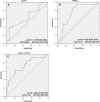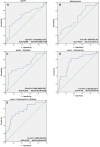Association of serum apoA-I with in-stent restenosis in coronary heart disease
- PMID: 35927634
- PMCID: PMC9354313
- DOI: 10.1186/s12872-022-02762-y
Association of serum apoA-I with in-stent restenosis in coronary heart disease
Abstract
Background: Despite use of drug-eluting stents (DES), in-stent restenosis (ISR) continues adversely affecting clinical outcomes of patients undergoing percutaneous coronary intervention (PCI). Apolipoprotein A-I (apoA-I) has athero-protective effects. However, there is a paucity of clinical data regarding the association between apoA-I and ISR. We sought to investigate whether serum apoA-I is related to ISR after DES-based PCI.
Methods: In this retrospective case control study, 604 consecutive patients who underwent DES implantation before were enrolled. Patients who underwent repeat angiography within 12 months were included in the early ISR study (n = 205), while those beyond 12 months were included in the late ISR study (n = 399). ISR was defined as the presence of > 50% diameter stenosis at the stent site or at its edges. Clinical characteristics were compared between ISR and non-ISR patients in the early and late ISR study, respectively, after adjusting for confounding factors by multivariate logistic regression, stratified analysis, and propensity score matching. The predictive value was assessed by univariate and multivariate logistic regression analysis, receiver operating characteristic (ROC) curve analysis, and quartile analysis.
Results: In the early ISR study, 8.8% (18 of 205) patients developed ISR. Serum apoA-I in the ISR group was lower than that in the non-ISR group (1.1 ± 0.26 vs. 1.24 ± 0.23, P < 0.05). On multivariate logistic regression analysis, apoA-I was an independent risk factor for early ISR. Incidence of early ISR showed negative correlation with apoA-I and could be predicted by the combined use of apoA-I and glycosylated hemoglobin (HbA1c) level. In the late ISR study, 21.8% (87 of 399) patients developed ISR. On subgroup analysis, late ISR showed negative correlation with apoA-I irrespective of intensive lipid lowering; on multivariate logistic regression analysis, apoA-I was also an independent risk factor for late ISR. In patients with intensive lipid lowering, combined use of apoA-I, stenting time, and diabetes predicted the incidence of late ISR.
Conclusions: ApoA-I was an independent risk factor for ISR, and showed a negative correlation with ISR after DES-based PCI. Combined use of apoA-I and clinical indicators may better predict the incidence of ISR under certain circumstances.
Keywords: Drug-eluting stents; In-stent restenosis; Prediction; apoA-I.
© 2022. The Author(s).
Conflict of interest statement
The authors declare that they have no competing interests.
Figures







Similar articles
-
The Relationship Between Serum SFRP5, ApoA-I, HDL3-C Level and In-Stent Restenosis After PCI in Acute Myocardial Infarction and the Combined Predictive Value.Kaohsiung J Med Sci. 2025 May;41(5):e70000. doi: 10.1002/kjm2.70000. Epub 2025 Mar 8. Kaohsiung J Med Sci. 2025. PMID: 40056066 Free PMC article.
-
Efficacy and Prediction Model Construction of Drug-Coated Balloon Combined with Cutting Balloon Angioplasty in the Treatment of Drug-Eluting Stent In-Stent Restenosis.Comput Math Methods Med. 2022 Sep 19;2022:9832622. doi: 10.1155/2022/9832622. eCollection 2022. Comput Math Methods Med. 2022. Retraction in: Comput Math Methods Med. 2023 Dec 13;2023:9824960. doi: 10.1155/2023/9824960. PMID: 36238492 Free PMC article. Retracted.
-
Risk factors for revascularization and in-stent restenosis in patients with triple-vessel disease after second-generation drug-eluting stent implantation: a retrospective analysis.BMC Cardiovasc Disord. 2021 Sep 17;21(1):446. doi: 10.1186/s12872-021-02259-0. BMC Cardiovasc Disord. 2021. PMID: 34535088 Free PMC article.
-
Stent failure: the diagnosis and management of intracoronary stent restenosis.Expert Rev Cardiovasc Ther. 2023 Jul-Dec;21(7):501-506. doi: 10.1080/14779072.2023.2221852. Epub 2023 Jun 5. Expert Rev Cardiovasc Ther. 2023. PMID: 37269322 Review.
-
Coronary In-Stent Restenosis: JACC State-of-the-Art Review.J Am Coll Cardiol. 2022 Jul 26;80(4):348-372. doi: 10.1016/j.jacc.2022.05.017. J Am Coll Cardiol. 2022. PMID: 35863852 Review.
Cited by
-
A systematic review and bioinformatic study on clinical, paraclinical, and genetic factors predisposing to stent restenosis following percutaneous coronary intervention.BMC Cardiovasc Disord. 2024 Jun 14;24(1):304. doi: 10.1186/s12872-024-03955-3. BMC Cardiovasc Disord. 2024. PMID: 38877398 Free PMC article.
References
-
- Taniwaki M, Stefanini GG, Silber S, Richardt G, Vranckx P, Serruys PW, et al. 4-year clinical outcomes and predictors of repeat revascularization in patients treated with new-generation drug-eluting stents: a report from the RESOLUTE All-Comers trial (A randomized comparison of a zotarolimus-eluting stent with an everolimus-eluting stent for percutaneous coronary intervention) J Am Coll Cardiol. 2014;63:1617–1625. doi: 10.1016/j.jacc.2013.12.036. - DOI - PubMed
-
- Jinnouchi H, Kuramitsu S, Shinozaki T, Tomoi Y, Hiromasa T, Kobayashi Y, et al. Difference of tissue characteristics between early and late restenosis after second-generation drug-eluting stents implantation—an optical coherence tomography study. Circ J. 2017;81:450–457. doi: 10.1253/circj.CJ-16-1069. - DOI - PubMed
MeSH terms
Substances
LinkOut - more resources
Full Text Sources
Miscellaneous

